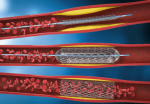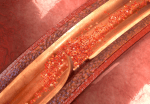Cardiovascular disease is the leading cause of death in elderly adults (individuals aged 75 years or older). In turn, coronary heart disease is one of the main causes of morbidity in this population. In addition to anatomical complexities, there are other factors that may complicate its management, such as polypharmacy, frailty, and procedure-related risks. All of...
Left Main Coronary Artery PCI: In What Scenario Could We Not Use IVUS?
Lesions in the left main coronary artery (LMCA) continue to pose a significant challenge. The use of coronary imaging before percutaneous coronary implantation (PCI) has proven useful in analyzing the lesion, identifying the presence and location of calcification, and determining lesion length in the LMCA, the left anterior descending artery, and the circumflex artery. Various...
Treatment and Gender-Based Outcomes for Coronary Bifurcation Stent Placement: Report from the e-ULTIMASTER Registry
Approximately 20% of all percutaneous coronary interventions (PCI) are performed on bifurcation lesions, which continue to pose a challenge in terms of strategy: how many stents to use, what is the most suitable strategy, and when to transition from a single stent to two during the procedure. Additionally, the use of two stents in these...
AMI following Coronary Artery Dissection: Higher Mortality?
Though rare, spontaneous coronary artery dissection (SCAD) might lead to MI, most commonly affecting young middle aged women. In these cases, the angiographic image will present a characteristic double lumen, and an intramural hematoma in the coronary artery wall. Normally, it will be treated medically. However, a small number of cases presenting STEMI will require...
MACT Study: Monotherapy with P2Y12 Inhibitor Associated with Colchicine after Acute Coronary Syndrome
Dual antiplatelet therapy (DAPT) is the current standard for preventing thrombotic events in high-risk patients with coronary artery disease, as well as in patients with acute coronary syndrome (ACS) undergoing percutaneous coronary intervention (PCI). However, this approach increases the risk of bleeding. To reduce this risk, there have been studies that discontinued the use of...
A New Alternative for the Treatment of Heart Failure: Left Atrial to Coronary Sinus Shunt with the APTURE Device
ALT FLOW device for left atrial to coronary sinus shunting in symptomatic heart failure patients. In the treatment of heart failure (HF), significant improvement in patient quality of life and prognosis has been achieved through appropriate medical treatment and, in some cases, the use of devices. However, in certain cases, satisfactory clinical improvement cannot be...
We Should Revascularize Patients with Stable Coronary Syndromes and Ischemia Assessed by iFR
Chronic stable angina has shown a good response to medical treatment, and the Ischemia study has recently demonstrated the safety of such treatment in stable chronic angina with moderate to severe ischemia. However, this study excluded left main coronary artery (LMCA) lesions. The FAME Study has shown the safety and efficacy of fractional flow reserve...
Intrastent Restenosis in Ostial Lesions in the Right Coronary Artery: Predictors of an Unfavorable Location
Predictors of intrastent restenosis in the right coronary artery ostium. The ostium of the right coronary artery (RCA) presents certain histological aspects. Atherosclerotic and fibrotic plaques in this area contain an abundance of smooth muscle, collagen, and a certain degree of calcification, along with thicker adventitia. Additionally, it has certain anatomical aspects such as poor...
5 Year Evolution of PCI vs CABG in Large Randomized Studies on Acute and Chronic Coronary Syndrome
Left main lesions in acute coronary syndrome (ACS) represent a major risk and, at present, the best revascularization strategy is a matter of debate. Though many studies and registries have excluded this group of patients, there is data on the pros and cons of both percutaneous coronary intervention (PCI) and cardiac artery bypass graft (CABG). ...
Invasive vs Conservative Treatment in Patients with Spontaneous Coronary Artery Dissection
The prevalence of spontaneous coronary artery dissection (SCAD) is around 4% of acute coronary syndromes (ACS). Even though the current guidelines recommend a conservative approach, as long as it is clinically viable, it remain unclear whether there are benefits to percutaneous coronary intervention (PCI) as an initial approach, to prevent disease progression and adverse events....








